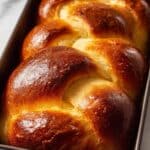Description
Classic French Brioche recipe with a rich, buttery crumb and delicate crust. This enriched dough bread is soft, fluffy, and subtly sweet, perfect for breakfast or dessert, made using a stand mixer and baked in the oven for the perfect golden finish.
Ingredients
Scale
Dough Ingredients
- 2 1/2 tsp instant/rapid rise dried yeast
- 4 tbsp warm full fat milk
- 2 cups plain/all purpose flour
- 3 1/2 tbsp caster/superfine sugar
- 1/2 cup eggs (2 1/2 eggs), lightly whisked, at room temperature
- 1 tsp cooking/kosher salt (not table salt)
- 150g / 10.5 tbsp unsalted butter, cut into 1.25 / 1/2″ pieces, softened (not melting)
Other
- Oil spray (neutral flavored – canola, vegetable, not olive oil)
- 1/2 leftover egg, lightly whisked (for egg wash)
Instructions
- Bloom yeast: In a small bowl, mix 1 tsp sugar, yeast and warm milk together. Cover with cling wrap and set aside in a warm place for 10 minutes or until foamy.
- Make dough: In the bowl of a stand mixer fitted with a dough hook, combine the flour, eggs, salt, remaining sugar and the foamy yeast mixture. Mix on speed 1 until ingredients combine.
- Mixing Part 1: Continue mixing on speed 1 for 5 minutes then increase to speed 2 for 10 minutes. This long mixing helps develop gluten despite the high fat content.
- Slowly add butter: With the mixer running on speed 2, gradually add softened butter cubes over 90 seconds to 2 minutes, allowing partial incorporation.
- Incorporate butter: Keep mixing on speed 2 for about 1 minute until butter is fully mixed in and dough becomes pasty and sticky.
- Mixing Part 2: Continue mixing on speed 2 for 20 more minutes, scraping down the bowl sides occasionally. The dough should form a soft, elastic ball that passes the windowpane test.
- First rise: Shape dough into a ball, place in the mixer bowl, cover with cling wrap and leave in a warm spot for 2 hours or until doubled in size.
- Divide and shape: Punch down the dough and turn it onto a floured surface. Fold dough inward 6 times, shape into a log and cut into 3 equal balls (~225g each).
- Chill dough: Place dough balls on oil-sprayed parchment in a deep container, cover and refrigerate for 1.5 hours to firm and smoothen the dough.
- Braid: Roll each dough ball into 14″ logs, braid the three logs, tuck ends under and place in a well-oiled 8.5×4.3″ loaf pan. Cover with oiled cling wrap.
- Second rise: Allow dough to rise in a warm place for 3 hours or until just over doubled in size.
- Preheat oven: Preheat oven to 200°C (390°F) or 180°C fan when dough is nearly ready. Position rack in the lower third.
- Egg wash: Gently brush the brioche surface with leftover whisked egg.
- Bake uncovered: Bake brioche uncovered for 15 minutes until deep golden brown.
- Bake covered: Remove from oven, loosely cover with foil, then bake additional 20 minutes until internal temperature reaches 88°C (190°F).
- Cool: Immediately remove brioche from pan and cool on a wire rack for at least 45 minutes before slicing or tearing.
- Serve: Serve warm with butter and jam or toast slices as desired.
Notes
- Yeast: Instant yeast is recommended and blooming it gives a higher rise and softer bread. If no foam appears during blooming, yeast is inactive and should be replaced.
- Milk: Use full-fat milk for best texture.
- Flour: All purpose/plain flour yields a softer crumb than bread flour.
- Sugar: Caster/superfine sugar blends better but granulated white sugar is acceptable.
- Eggs: Use 2 1/2 eggs to measure 1/2 cup whisked eggs; leftover 1/2 egg is used for egg wash.
- Salt: Use cooking/kosher salt; reduce quantity if using fine table salt.
- Butter: Softened but not melting, ideally 20–22°C (68–71.5°F).
- Mixing Time: Long kneading develops gluten despite high fat content; dough should pass windowpane test for elasticity.
- Adding Butter: Add gradually to ensure incorporation and prevent greasy dough.
- Windowpane Test: Stretch a walnut-size dough piece to thin translucent sheet without breaking to check gluten development.
- Dough Consistency: Adjust flour or milk slightly if dough too sticky or crumbly.
- Chilling dough: Optional but improves handling and surface smoothness.
- Second Rise: Dough will rise about 1cm above loaf pan rim.
- Baking Temperature: Internal baked temperature of 88°C (190°F) is ideal for enriched dough like brioche.
- Storage: Freeze brioche for up to 3 months; reheat wrapped in foil at 180°C (350°F) for 10–15 minutes.
- Alternate Method: Food processor method available for dough mixing.
Nutrition
- Serving Size: 1 slice (1/16 loaf)
- Calories: 225 kcal
- Sugar: 4 g
- Sodium: 150 mg
- Fat: 12 g
- Saturated Fat: 7 g
- Unsaturated Fat: 4 g
- Trans Fat: 0 g
- Carbohydrates: 25 g
- Fiber: 1 g
- Protein: 5 g
- Cholesterol: 55 mg

